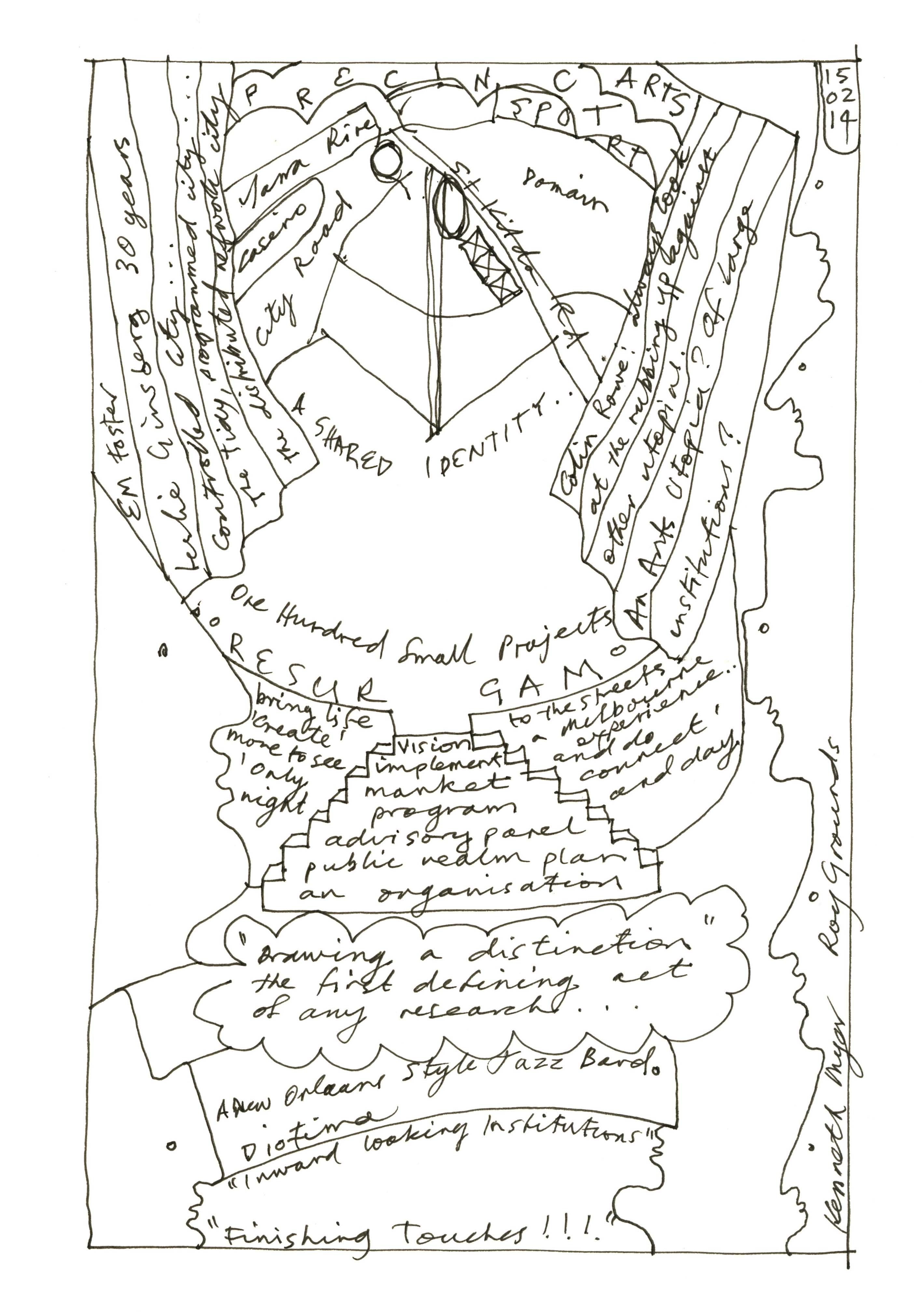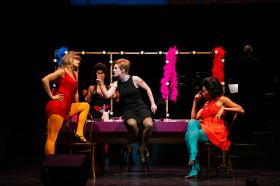Street life doesn’t come from precinct thinking Photo: The Ministry of Manipulation
Published in the same week as the first ABS quantification of the massive contribution to our economy of the ‘cultural creative sector’ the Melbourne Arts Precinct Blueprint surfed in on a wave of optimism about possible future investment in the arts. This swept through the arts community and ended up in the editorials of The Age newspaper. Certainly the gratifying finding that the cultural sector makes a contribution in the same league as manufacturing and mining and greater than other sectors such as transport and welfare would seem to validate the investments that are made in this sector, and prompt more.
But is this blueprint a good guide to that investment? I don’t think so. Why? In my view the strategy rests on a number of questionable assumptions. The first resides in its title: what evidence is there that an ‘Arts Precinct’ is in any way a desirable thing for a city to have? This smacks of the ‘lets tidy up the city’ thinking of planners from the mid twentieth century. Thanks to them cities around the world are encumbered with problematic arts ghettos; constantly sucking in public monies as they struggle (as this blueprint does) to ‘bring life’ ‘night and day’ to their open spaces. Such precinct thinking is engulfing central Melbourne and the Sports Precinct, for example, grows ever more isolated from any ‘life’ other than that of major events. Precincts tend to homogenize our experience of the city, delivering us passively into the realm of bread and circuses, of city living as the consumption of spectacles. Sporting accomplishment and cultural achievement do not begin in such precincts, though of course experiences there may inspire ambitions. Individual achievement grows up in the distributed city, at home, in neighbourhoods and schools, in clubs and societies spread through every suburb and country town.
Sneering at the ‘inward looking institutions’ that compete to provide access to peak experiences in the Arts gives the authors of this report the energy to segue to depictions of an area transformed into ‘life’. But ‘life’ as depicted in this blueprint, including ‘New Orleans style jazz bands’ is something plucked from elsewhere and programmed by some apparatchik and delivered into the streets and spaces on a ‘rolling program’ of consumable entertainment. Would that this report offered more towards the creation of a continuum between experimental and emerging practices and the staging of established and international practice, a continuum that is discussed earnestly within those ‘inward looking institutions.’
There is an emphasis on coordinated government action at Federal, State and City level. Is this really a government matter? Although this report uses the Maoist phrase calling for the blooming of a hundred flowers, here as in China governments aren’t good at this…
Further I question the urban design proposition for the area. Why is this conceived of as a unity centred on a street? Why not work with grid disruptions as Mario Gandelsonas’ research (1988-90) suggests we should in grid cities of the new world? Why not embrace the ways in which the gritty energy of cities emerges where very different city conditions rub up against each other, as Colin Rowe’s Collage City (1978) taught us? How maximising difference leads to real diversity? If we want unpredicted and vital new life to flow into this area, then – for example – land ownership and land parcel sizing must be addressed, allowing private funding to filter in between the large institutions. This after all is what makes the here lauded laneways of the city work.
Laneways are not programmed, except questionably for graffiti manifestations…. There are opportunities that enterprising start-ups can afford, and budding entrepreneurs do what this report wants some agency to do. Very old fashioned socialist centralist this… The idea that a vibrant area of city can have ‘finishing touches’ put to it reeks of centralised planning and the dead hand of cultural precincts everywhere. If only Sturt Street was so undesirable that no institution would look at it, if only it was surrounded by cheap obsolete factory units… As it is artists needing studios, having moved up into Brunswick, are now finding spaces on warehouse sites across the South East. That’s where new art is happening, and as Nikos Papastergiadis’ research shows us, where artists, artistes and designers can find affordable space they do the work that propels the cultural sector. This is not done by a bunch of bureaucrats or marketers ‘creating a Melbourne Experience’ nor by a global accounting firm comparing cultural centres as if we are certain that they are what we all should aspire for!
Sites of opportunity are identified here, but they all seem to be of a similar size, and nominated for future institutional use. Well, it is recommended that the City develop a plan. But there is no evidence that the City understands these issues – look at the misery of Docklands, and the way in which it has been parcelled up so that only huge developer projects are possible. On the 17th June 2006 The Age pointed this out (Docklands, a wasted opportunity?) and many private submissions were made before that, but to deaf ears. Now (The Age, 13th February 2014, Desolate Docklands needs a major overhaul, say experts) these concerns and suggestions are restated by yet another set of consultants, at what cost?
To oversee this precinct this blueprint recommends that government creates an ‘advisory panel’ and that it ‘identify and resource an institution’ to run the whole thing, a thing that has cost $900,000 to date! Imagine how many creative groups could have been supported by that sum! This vision implemented would in my view pour more money into the pockets of consultants and another set of reports will moulder on shelves, like all the previous master-plans, and the advice of a committee will moderate the energy out of all the unlikely and unexpected ventures that might raise their heads.
If anything does work for this area it will be as a consequence of some particular person or persons with an appetite for persistent confronting of land tenure and other planning issues that dog every innovation in this city; and it will depend on individual entrepreneurs of every kind inside and outside the institutions.

An ideogrammatic representation of the Arts Precinct Blueprint by Leon van Shaik
For more on this issue, see Why Cultural Precincts Never Work by Ben Eltham.






